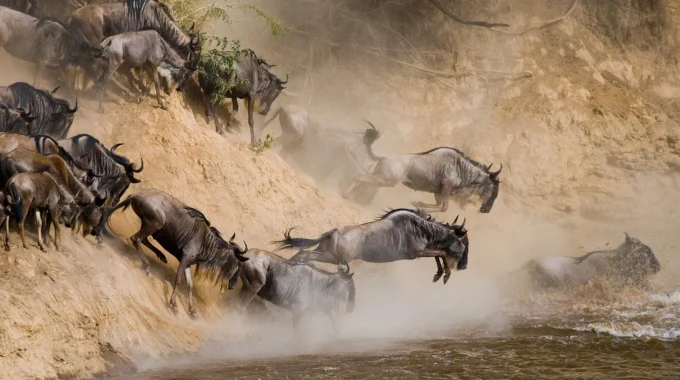A Kenya safari cost can vary significantly based on several factors, such as the season,…
Peak of the Great Migration
Peak of the Great Migration – The Great Wildebeest Migration is a year-round event that spans both Tanzania and Kenya, but the peak of the migration — when the action is most dramatic and the wildlife experience is at its best — occurs during specific months in each country. The peak of the migration in both Kenya and Tanzania generally takes place from July to October. Here’s an overview of what to expect in both countries during this time.

Peak of the Great Migration: July to October
This is the period when the wildebeest herds are in the northern Serengeti (Tanzania) and Maasai Mara (Kenya), and it’s the most iconic and dramatic time to witness the migration.
Kenya: Maasai Mara (July to October)
- July to October is the peak of the migration in Kenya. During these months, the wildebeests and other animals arrive in the Maasai Mara (located in southwestern Kenya), crossing over from the northern Serengeti in Tanzania.
- Mara River Crossings: The wildebeests face one of the greatest challenges of their migration — crossing the Mara River. This is the highlight of the migration in Kenya, as the wildebeests have to navigate crocodile-infested waters and avoid predators waiting on the banks. The river crossings can be dramatic, with thousands of wildebeests crossing in a single day.
- Wildlife Action: Along with the river crossings, you’ll witness a high concentration of predators (lions, leopards, cheetahs, and hyenas) that are drawn to the migrating herds. The dry season (July to October) makes wildlife viewing excellent in the Maasai Mara, as the grass is shorter, making it easier to spot animals.
- Best Areas to Visit in Kenya:
- Mara River: This is the focal point of the migration in Kenya. Some of the best places to view the river crossings are Kichwa Tembo, Mara North Conservancy, and the Mara Triangle.
- Central Maasai Mara: The central part of the Maasai Mara also offers great opportunities to see the herds spread out over the plains.
Tanzania: Serengeti (July to October)
In Tanzania, the peak of the migration also occurs from July to October, specifically in the northern Serengeti. This is when the wildebeests are preparing to cross into the Maasai Mara in Kenya.
- Mara River Crossings: The Mara River (which straddles the border between Tanzania and Kenya) is where the migration’s most iconic river crossings take place. The wildebeests face the perilous journey of crossing the Mara River, often having to leap into the water, where they are vulnerable to crocodiles and predators. The herds typically arrive in the northern Serengeti from July onward and begin crossing the Mara River toward the Maasai Mara.
- Grumeti River Crossings (June/July): Before reaching the Mara River, wildebeests often face another river crossing challenge at the Grumeti River in the western Serengeti. This crossing occurs earlier, around June to July, and can be just as dramatic, though it’s less well-known than the Mara River crossings.
- Wildlife Action: The northern Serengeti is teeming with life during this time. As the wildebeests head north, predators are close behind. The action is intense with lions, leopards, and cheetahs hunting the vulnerable wildebeests, especially during the river crossings.
- Best Areas to Visit in Tanzania:
- Northern Serengeti: The best areas to witness the Mara River crossings are in the northern Serengeti near Kogatende, Mara River, and Lamai Wedge.
- Western Serengeti: The Grumeti River in the western Serengeti also offers opportunities to see wildebeests crossing before they make their way north. This is an excellent time for fewer crowds but still significant migration action.
Why July to October is the Peak
- Mara River Crossings (Iconic Moments): Both in Kenya and Tanzania, the highlight of the migration season is the Mara River crossing. This dramatic and often dangerous crossing, where wildebeests brave the river’s strong currents, crocodiles, and predators, is the most visually stunning part of the migration.
- Predator-Prey Action: During this time, there’s an abundance of predators (lions, leopards, cheetahs, hyenas) in the area, and the concentration of prey (wildebeests, zebras, gazelles) is at its highest. This makes for thrilling safari experiences with lots of action and the potential to witness hunts, kills, and dramatic predator-prey interactions.
- Great Wildlife Viewing Conditions: The dry season (July to October) in both Kenya and Tanzania offers the best conditions for wildlife viewing. The vegetation is shorter, and the animals tend to congregate around waterholes, making them easier to spot. The weather is generally sunny and dry, which also makes for pleasant safari conditions.
Summary: Best Time for the Great Migration in Kenya & Tanzania
- Best Time to Visit: July to October is the peak of the Great Migration when the wildebeests are crossing the Mara River, and the action is at its height. This is the ideal time to witness dramatic river crossings, large herds, and predator-prey interactions.
- In Tanzania: The peak migration action in the northern Serengeti occurs from July to October, with the highlight being the Mara River crossings.
- In Kenya: The peak of the migration is also July to October, when the herds have arrived in the Maasai Mara and are attempting the Mara River crossings.
This period is the most popular time for safaris to witness the Great Wildebeest Migration, though it can be crowded, especially near the river crossings. If you want to avoid crowds and still see significant migration action, consider visiting at the beginning of the season (late June) or the tail end (early October).



